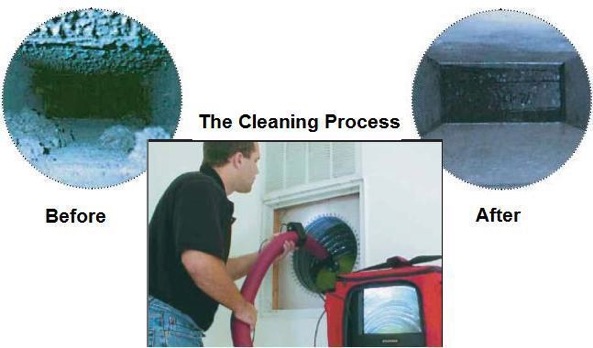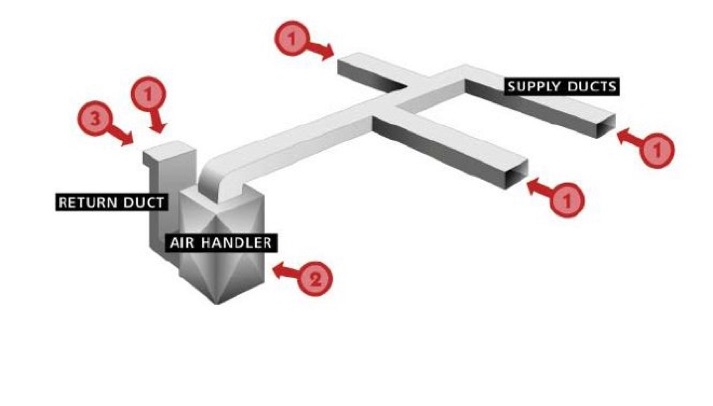Central HVAC systems are essentially the respiratory system for a buildings indoor environment. There are many reasons why a every homeowner should clean the HVAC at least every five years (people who smoke, have pets, have respiratory problems, are allergic to mold, mildew and pollen, have had rodent problems, or have a central air system that utilizes a standard throw-away fiberglass filter, need to clean their air ducts more often usually every 2-3 years). If you have just had any construction done you should clean the ducts as soon as it is all finished.
Common issues of structures with indoor air pollution are: excessive dust in the house and musty odors when the heat or A/C is running. Common health symptoms of people affected by indoor air pollution are: allergies, sinus problems, nasal congestion, headaches, nausea, problems sleeping, burning sensations in the eyes, nose or throat that happens more frequently when inside the structure than when outside. Even though some people are immune to the effects of bad indoor air quality, lack of symptoms doesn’t mean the problem irritants are not present in your system, it may mean your respiratory system is stronger than others. The fact is dirt and other irritants are going to accumulate in every HVAC system over time. So, the question is do you want to leave irritants in the system until they cause a health problem? Doctors know for a fact that indoor air pollution can cause many ailments, and make the health problems your family already has (especially allergies, hay fever, asthma and bronchitis) worse, that’s why so many doctors, especially those who specialize in allergic reactions and respiratory issues recommend having your air ducts cleaned regularly.
Our state of the art video guided rotating brush head and powerful vacuum system removes on a typical job 5 to 15 pounds of dirt and debris. Scientific studies show the things commonly found in HVAC systems are dust, dirt, and other soils, synthetic materials from furniture, drapes, carpets, etc., soot from the heating system’s exhaust (which is a dangerous carcinogenic - prevent this from entering the system in the first place by having the chimney regularly swept), paint dust, drywall dust, fiberglass fragments from insulation, construction materials, rodent carcasses, feces and nesting, animal dander, all kinds of hair (human and animal), pollen, skin scale, bacteria, viruses, mold, mildew, fungus, insect remains and feces (which can be a powerful irritant) and in older homes asbestos. If dust mites and their feces are present in your HVAC system our cleaning process easily removes them (although reports of this problem are usually something else).
As you can clearly see many factors contribute to poor indoor air quality, but the largest factor is particulate dust and microbial contamination in the air we breathe. Capable of being breathed deeply into the lungs, the most dangerous particulate are not even visible to the human eye as they are sub-micron in size. These microscopic particles can be in the form of insect feces or other airborne contaminates that are continually circulated by the ventilation systems through your home or business. It is this range of particle size that creates the most concerning particles, because this size becomes deposited on our lungs causing the majority of respiratory irritations and reactions. Since the ducts and the air handler can harbor these pollutants, regularly removing any potential source contamination from the ventilation system is considered good practice.
Another factor in having your air ducts cleaned is the fact that cleaning your system can help lower your heating and air conditioning costs by making your system operate as efficiently as it was designed to. Just a small amount of dust or debris in the system effectively shrinks the size of the ducting making it harder for the system to move air properly so you will use more energy to maintain your temperature settings. Also, because it’s harder for the system to move air this will shorten the life of your heating equipment, because under a heavier load parts and motors will wear out faster.
The EPA (Environmental Protection Agency) says that indoor air quality is up to 100 times worse than outdoor air quality. Because we sleep indoors and spend a total of 90% of our time (on average) indoors, cleaning what lies hidden in the air ducts of your heating or air conditioning system will result in a much healthier indoor environment for you and your family.
The Chimney Saver Air Duct Cleaning process is as simple as 1, 2, 3. Our cleaning process is effective in all types of ductwork including sheet-metal, flex-duct and fiber-board ductwork (old, now illegal, ducts made from the space between ceiling and floor joists with exposed lumber can not be cleaned well by any system). The system includes video inspection and monitoring of the cleaning process so you can see what is being cleaned inside the ductwork. Let's face it all air ducts would be most efficiently cleaned by simply crawling inside the ducts and hand vacuuming and brushing. Since that is not practical we use the only self contained method that brushes and vacuums debris all at the same time, unlike truck mounted systems that use compressed air to blow debris through your entire HVAC system before being sucked into the vacuum system in the truck, with our system dirt and debris are brushed loose by the spinning brush head and then immediately vacuumed up behind the brush by a powerful dual motor HEPA vacuum (some extremely twisted ductwork may require us to use the compressed air and central vacuum technique - that’s why we have both systems, but the latter is our preferred method). The brush / vac head is directed by our video camera monitoring system that is mounted directly to the head, to go through every single inch of your HVAC systems ductwork. Again, this system is absolutely the best way to clean air ducts because it's the only system that doesn't need a central collection unit attached to the plenum and since we don't need that, all of the dirt and debris do not have to travel through the entire HVAC system before being collected. Also our spinning brush cleans and scrubs like no compressed air system can. Our brushes are soft (like car washing brushes) so they will not damage even the most delicate of ductwork. Make sure that the company you hire uses this type of system because nothing is better.
Call today for an appointment
1-800-945-0947

Why Should you Clean your Air Ducts - Registers & Return Vents

Step 1 - Cleaning the Air Ducts
Remove and clean the registers. with Chimney Savers patented system, we start cleaning through the supply vents and work our way back to the air handler. As we work back through the system much of the ductwork actually gets overlapped. This ensures that the ductwork is getting cleaned properly. Then we clean the cold air return ductwork with the same process.
Step 2 - Cleaning the Air Handler
We then use our cleaning system to vacuum and topically clean the air handler.
Step 3 - Apply the Antimicrobial into the System
(Optional Step) We turn on the air handler fan and fog the system (we have several different fogging options including a USDA certified organic disinfectant) to disperse the antimicrobial treatment into the cold air return, the fan will then circulate the treatment deep into the system.